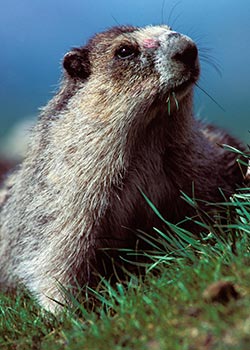Lost Lake Trail

Notable Species
- Black bear
- Brown bear
- Hoary marmot
- Mountain goat
- Spruce grouse
- Willow and rock ptarmigan
- American pipit
- Gray-crowned rosy-finch
The first four miles of this seven-mile trail climb through temperate rainforest before emerging into open country. Look for forest birds such as fox sparrows, chickadees, thrushes, gray jays and spruce grouse. Alpine tundra draws out gray-crowned Rosy finch, ptarmigan and American pipits. Black and brown bears use the habitat, along with moose. Marmots bask and feed in rocky areas above tree line—listen for their sharp, whistled alarm calls. Mountain goats forage on steep slopes of Ascension Peak overlooking the lake.
Habitat
The trail begins in a mossy low-elevation Sitka spruce forest only a few miles from the sea and then climbs through a succession of habitats until it breaks out into subalpine tundra. The valley surrounding Lost Lake is known for its meadows of flowers.
Recreation Connection
The Lost Lake Trail connects to the Primrose Trail for a possible 15-mile through hike. It traverses one of the most accessible tundra valleys and alpine lakes on the Kenai Peninsula.
Viewing Tip
Begin early in the day with enough time (the Forest Service suggests 6-8 hours round trip) for a leisurely visit to the world above treeline. Watch closely for animals in transition zones between habitats: the shift from forest to brush, brush to tundra.
Helpful Hints
Prepare for backcountry travel with appropriate clothing, water and food.
Getting There
Seward Highway milepost 5. Turn west at the Lost Lake subdivision, turn left on Heather Lee Lane, right on Hayden Berlin Road. The road ends at a broad parking lot. www.fs.fed.us/r10/chugach/seward/rec/trails/lost.htm.
